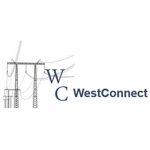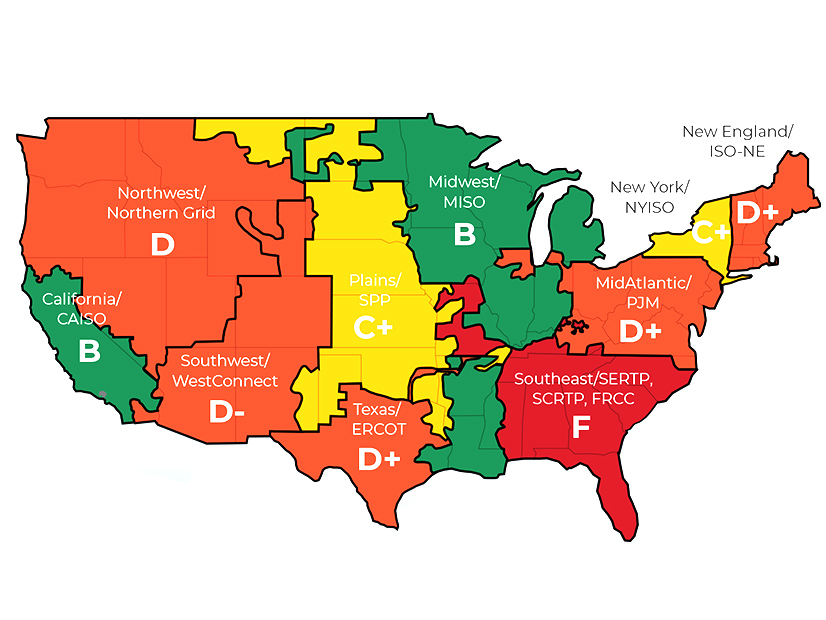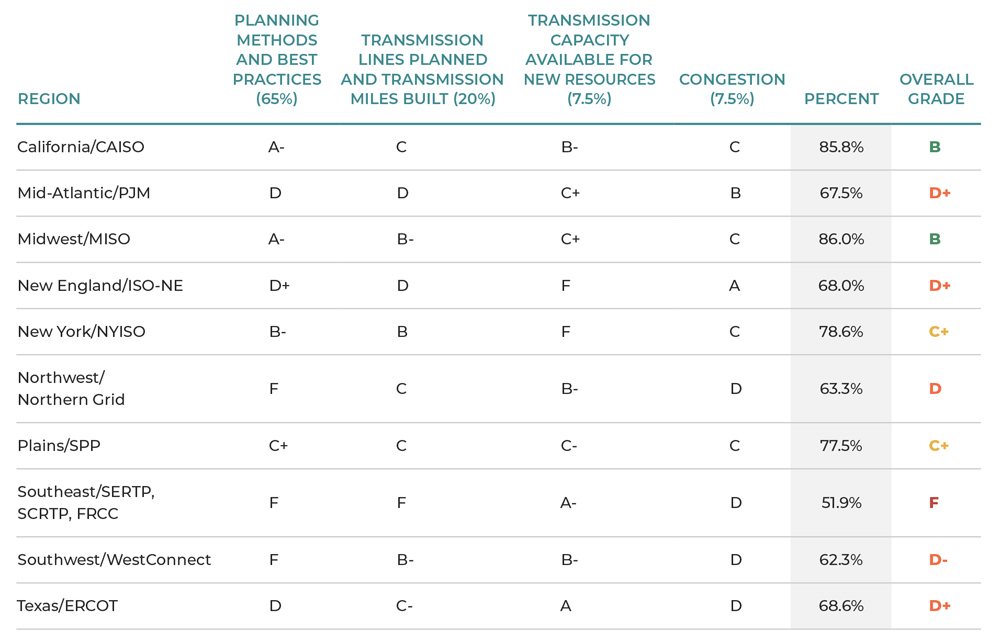MISO and CAISO received above-average marks while other regions got middling to failing grades in a “report card” on transmission planning and development published last week by Americans for a Clean Energy Grid.
“Overall the grades leave a lot of room for improvement,” ACEG said in its report, which it intends to spur discussion about how the FERC Order 1000 transmission planning regions can improve their efforts.
“We hope parties in each region can see positive examples in other ones from which they might learn,” ACEG said. “Our intent is not to criticize. Instead, we aim to show that good performance is possible and achievable, and all regions can improve to reach an ‘A’ grade in the coming years.”
The Southeast region has the most room for improvement, “while the West (minus California), Mid-Atlantic (PJM), New England (ISO-NE) and Texas are also lagging in their planning and development efforts,” ACEG said.
ACEG represents a broad coalition of clean energy and conservation groups and companies such as Berkshire Hathaway Energy, Google and NextEra Energy, all “focused on the need to expand, integrate, and modernize the North American high-voltage grid.”
In its report, the group said FERC Order 1000 and the commission’s other efforts to promote regional planning have produced “lackluster” results.
In response, FERC issued a Notice of Proposed Rulemaking in April 2022 to require long-term regional transmission planning and increased state involvement in transmission cost allocation, among many other changes (RM21-17). (See Battle Lines Drawn on FERC Tx Planning NOPR.)
“The NOPR acknowledges that regional planning under Order No. 1000 failed to adequately plan for and meet transmission needs, driven largely by the changing resource mix and increasing load,” ACEG said.
ACEG is pleased to see growing recognition of the need for proactive transmission planning, Executive Director Christina Hayes said in a statement accompanying the report. “Without continued improvement, the U.S. grid will remain a barrier to reaching our climate goals, and result in more dangerous power outages that threaten lives and livelihoods.”
Assessing Transmission Capacity
The “Transmission Planning and Development Regional Report Card” was written by Grid Strategies Research and Policy Manager Zach Zimmerman. Hayes and Grid Strategies President Rob Gramlich helped develop its methodologies and analysis.
The report evaluates the performance of Order 1000 planning regions, not specific entities such as RTOs, because “many parties, besides the planning entities, bear responsibility for performance, including utilities, states, and other stakeholders,” it said.
It employs four metrics to grade the regions: planning methods and best practices; miles of transmission built and future transmission plans (i.e., plans that go beyond reliability upgrades); transmission capacity available for new resources; and congestion ($/MWh).
Transmission capacity available for new resources combined three metrics — cost to interconnect, time in queue, and project completion rate — “all of which indicate whether a region’s system has sufficient transmission capacity to connect new generation,” it said.
“No single metric is entirely dispositive, but in combination, they provide an accurate assessment of transmission capacity,” ACEG said.
Based on the criteria, Midwest/MISO and California/CAISO each earned a “B.” New York/NYISO and Plains/SPP received grades of “C+.” The report card gave “D’s” to Mid-Atlantic/PJM, New England/ISO-NE, Texas/ERCOT, Northwest/Northern Grid and Southwest/West Connect.
The Southeast region — composed of Southeast Regional Transmission Planning (SERTP), South Carolina Regional Transmission Planning (SCRTP) and Florida Reliability Coordinating Council (FRCC) — got an “F.”
Midwest/MISO
Transmission planning efforts earned MISO and CAISO their relatively high marks.
ACEG said MISO’s “B” grade — and its 86% score, the study’s highest — resulted largely from the ISO’s work on its 2011 Multi-Value Projects initiative and its first, $10-billion long-range transmission plan (LRTP) portfolio. The ISO would have received an even higher score if not for MISO South, “where relatively little transmission planning activity occurs,” the report said.
MISO said it plans to address system needs in MISO South and to establish stronger connections between its South and Midwest areas in future iterations of its LTRP effort. The grid operator also pointed out that its first LRTP portfolio is “one of the largest transmission portfolios in U.S. history.”
“Although we have not had the opportunity to fully review the report, MISO’s ranking highlights our continued focus on planning a reliable grid of the future,” MISO spokesperson Brandon Morris said in an emailed statement. “This is why transmission evolution is a key pillar of our ‘Response to the Reliability Imperative’ efforts.”
MISO refers to its joint responsibility with its members to ensure that the clean energy transition occurs in a reliable and orderly manner as its “reliability imperative.” It issued its latest report on those efforts in January.
California/CAISO
CAISO’s “proactive, scenario-based, multivalue” transmission planning over the past two years accounted for its high score, which at 85.8% nearly matched MISO’s.
The report highlights the ISO’s work with the California Public Utilities Commission and California Energy Commission to plan collaboratively for the state’s clean energy future and coordinate resource procurement and transmission development.
It commended CAISO’s inaugural 20-year transmission outlook, approved last year, which examined in-state needs and transmission lines required to import large quantities of wind energy from Wyoming and New Mexico. And it cited the ISO’s most recent transmission plan, which broke with CAISO’s traditional planning process to bring needed resources online faster while dealing with an interconnection queue that has grown too large and unworkable.
ACEG awarded CAISO an “A-” for its planning efforts but only a “C” for lines planned and built, giving it an overall grade of “B.”
“Although it received one of the highest grades with a ‘B,’ there is still room for improvement,” the report said. “California needs to develop the lines it is planning, which could create a congestion-specific metric and provide better public access to good interconnection cost data.”
In addition, “California receives a higher grade than most regions for taking a relatively successful and innovative approach to interregional planning,” it said.
CAISO’s 2021-22 transmission plan noted that the “interregional coordination process [with NorthernGrid and WestConnect] has not met expectations.”
As an alternative, “CAISO has implemented programs to enable import transmission from other regions, such as making the TransWest Transmission line a part of its balancing authority even though it is not in California, and the cost of the line will be paid for by off-takers,” the report said.
TransWest Express, which recently broke ground, will link Wyoming wind to markets in California and the desert Southwest.
“We are pleased that ACEG highlighted the value of this complex effort to develop a vision for what the transmission system will look like in 2040, and appreciative of close cooperation from the California Energy Commission and the California Public Utilities Commission,” CAISO Vice President Neil Millar said in a statement to RTO Insider.
New York/NYISO
After MISO and CAISO, New York/NYISO was the next highest scoring region with a 78.6% total, earning it a “C+,” “based on their transmission planning methods and recently developed plans for new transmission,” the report card said.
The grade reflected NYISO’s public-policy transmission planning processes, which identify high-voltage transmission projects necessary for New York’s transition to clean energy. It also gave NYISO good marks for building projects.
NYISO has a “proactive, scenario-based planning process … [that] incorporates multiple cases and scenarios over a 20-year evaluation time horizon and uses reliability, economic, and public policy metrics to evaluate projects and select a transmission solution,” ACEG said. “For example, New York, in its 2019 public policy transmission plan, studied transmission lines using three scenarios, including a base case, Clean Energy Standard and Retirement Scenario.”
“This planning process is why New York is graded relatively well,” it said.
New York has also succeeded in getting important transmission projects built, it said. “After many years of little planning, persistent congestion and little transmission, New York has improved dramatically in the last few years,” it said. “Significant lines connecting Quebec, upstate, and downstate areas reduced congestion, improved reliability, and achieved public policy goals.”
ACEG said that while “NYISO does very little proactive interregional transmission planning,” the recent lines, such as those connecting it to Quebec, might signal a more proactive approach.
NYISO’s cumulative grade might have been higher except for the “F” ACEG gave it for transmission capacity available for new resources. NYISO deserved the failing grade because New York had by far the slowest completion score (0% compared with 65% for SPP, the next lowest scorer) for getting new resources out of its interconnection queue studies and onto the grid, the report said.
In an email, NYISO responded that “New York has recently seen the most significant investment in new transmission in decades through the NYISO’s Public Policy Transmission Planning Process. While the process has been a great success, the NYISO has called for significant additional transmission investment through its Public Policy Transmission Planning Process to support the achievement of public policy requirements.”
“The NYISO’s System Resource Outlook report from 2022 found that extensive transmission investments will be necessary to deliver renewable energy to consumers and address new constraints from the future addition of new resources,” it said.
Plains/SPP

The report card gave SPP a “C+” while saying it has the potential to achieve an “A” if it continues with its planning upgrades.
The report points to SPP’s developing consolidated planning process (CPP), which integrates its transmission planning and generator interconnection processes. The CPP’s intent is to determine the transmission needed to interconnect new generation, provide transmission service, maintain reliability and resiliency and relieve congestion.
SPP also overhauled its generator interconnection process, instituting a three-phase approach that FERC approved last year, and says it is “aggressively” clearing the queue.
The grid operator currently has 556 projects in its queue, representing 111 GW of capacity; 43% of the proposed projects are solar resources.
According to the report, the Plains region has one of the lower completion rates for new projects, with a capacity-weighted rate of 2% for those entering the queue in 2017 and reaching commercial operation. In 2022, ACEG said SPP received almost triple the interconnection requests compared to their next-highest queue year in 2021.
“This historic queue will likely lead to problems going forward,” the report said.
Congestion is increasing in the Plains, thanks to significant curtailment of wind generation in recent years. The RTO’s Market Monitoring Unit reported in the 2022 State of the Market that average hourly curtailments increased “substantially” from 244 MW in 2020 to 1,260 MW in 2022.
ACEG credited SPP for its Joint Targeted Interconnection Queue (JTIQ) work with MISO but noted the process is “not necessarily reflective of all planning best practices … and primarily focused on generator interconnection requests.”
SPP could also “better incorporate” merchant developers into its planning, ACEG said.
The JTIQ process has identified 400 miles of projects on the seams valued at over $1 billion in investments, but their cost allocation has yet to be approved. SPP also has almost 700 miles of new lines planned or in development within its near-term and long-range transmission plans, representing a roughly $2 billion investment.
Texas/ERCOT

ERCOT, which delivers about 90% of the state’s electricity to 26 million Texas customers, was given one of the report’s lower scores, a “D+.”
ACEG awarded ERCOT high marks on interconnection but said it needs to address congestion soon.
ERCOT’s Independent Market Monitor’s 2022 State of the Market report said real-time congestion costs in ERCOT rose 37% last year to $2.8 billion.
Texas’ interconnection process uses a “connect and manage” approach to integrated interconnection and transmission planning, the report said. New generators only pay for their connection to the grid, as opposed to the “broader systems or affected interregional system costs that generators in other regions have to pay.” The generators don’t receive firm transmission rights and grid operators curtail them more quickly, ACEG said.
“However, easy interconnection without proactive planning can lead to congestion and curtailment as significant amounts of generation are added, filling up existing transmission capacity,” the report said.
Lawrence Berkeley National Laboratory’s 2022 Interconnection Queue report found Texas has the highest project completion rate of any region — 28% of capacity-weighted projects were commercialized — and one of the lowest wait times at 18 months. ERCOT’s queue has 902 projects and 250 GW under study, according to the ACEG report.
The report calls for ERCOT to adopt more “proactive, scenario-based, multivalue transmission planning.”
ERCOT’s latest regional transmission plan only identified new lines required for reliability upgrades over a six-year horizon, ACEG said. While Texas did build 2,400 miles of new transmission as part of the 2010-13 competitive renewable energy zones project, those projects are fully subscribed, the report said.
ACEG also said there is a “major need” for interregional transmission in Texas, as was made clear during the deadly 2021 winter storm. In dire need for energy to save a grid that couldn’t meet demand, the state was limited in what it could import from its neighbors.
As an islanded interconnection, Texas maintains its jurisdictional freedom from FERC by not mixing its electrons with those of its neighbors.
Legislation following the deadly 2021 winter storm has strengthened the Texas Public Utility Commission’s oversight of ERCOT’s transmission process. The PUC can direct ERCOT to build certain transmission facilities and a new law has cut the time to approve transmission certifications from 360 days to 180.
New England/ISO-NE

ISO-NE’s lack of proactive planning methods led to a low overall score, ACEG said, but the RTO received an “A” on the congestion metric.
ACEG found that transmission planning in New England “has traditionally focused on reliability and been reactive, rather than proactive,” noting that a significant buildout of transmission in the early 2000s cut down on congestion, but new resources in remote areas remain constrained. The report also said that ISO-NE would benefit from increased interregional planning.
“New England has done very little to coordinate with New York despite a rapidly growing amount of offshore wind hoping to interconnect close to the seam of both regions,” the report said.
In response, an ISO-NE representative highlighted the region’s history of making significant transmission investments, including almost $12 billion in grid upgrades since 2002.
“We have and will continue to work collaboratively with the New England states and energy stakeholders to determine how the region can build upon past success as the states look to meet their aggressive climate goals,” ISO-NE said.
In June, the New England states, New York and New Jersey, sent a letter to the US Department of Energy asking for federal assistance to establish a Northeast States Collaborative on Interregional Transmission, while ISO-NE, NYISO, and PJM supported the proposal in a separate letter.
The Collaborative would enable the states to “work in partnership to explore opportunities for increased interconnectivity, including for offshore wind, between our regions.”
Mid-Atlantic/PJM

PJM scored poorly in the report, which gave it low rankings for all categories except on its stakeholder process and governance. Its total planning grade was 65%, a letter grade of “D.”
ACEG faulted PJM for not considering if transmission proposals could be better addressed through regional projects, not conducting proactive generation and load forecasting and not modeling expected retirements in its 15-year planning period.
While there has been some use of the MISO-PJM Targeted Market Efficiency Process (TMEP), ACEG said interregional planning remains minimal, despite potential benefits related to offshore wind development coordination with the New York and New England regions. Coordination with MISO remains largely limited to operational reliability or short lead-time projects.
The report states that merchant developer proposals are studied through PJM’s backlogged interconnection process, which has resulted in FERC complaints about delays.
PJM spokesperson Jeff Shields responded to the report by pointing to the Summer Reliability Assessment released by NERC in May, which found much of the country outside of PJM is at an elevated reliability risk. He said work is already underway on expanding its planning methods as outlined in its Grid of the Future Paper released last year.
He said PJM’s queue overhaul, approved by the commission in December, will go into effect this month.
“The reforms will speed up and streamline generation interconnection requests, improve project cost certainty, and significantly improve the process by which new and upgraded generation resources are introduced onto the electrical grid,” he said.
Though he argued that PJM has made strides in improving the turnaround for interconnection requests, Shields said many projects that the RTO has completed studies on have yet to be built due to factors beyond its control.
“Today there are 44,000 MW of mostly renewable generation resources that have cleared the PJM study process but have yet to be built. The developers of these projects have everything they need from PJM to move forward with construction, but they are not building. We continue to hear that there are a number of factors unrelated to PJM that are causing delays, including supply chain, siting, regulatory issues or financing,” he said.
Northwest/Southwest

In the non-CAISO West, the Northwest/NorthernGrid planning region received a “D” grade, and the Southwest/WestConnect region earned a “D-.” Both are Order 1000 regional planning entities ostensibly responsible for grid planning across most of the Western Interconnection.
“NorthernGrid and WestConnect have not conducted proactive planning,” ACEG said. “The work of individual utilities or states in the region is much of why the regions managed a ‘D’ grade.”
Both regions received an “F” for planning methods and a “D” for congestion but significantly better grades for transmission capacity for new resources (B-minuses) and transmission lines planned and miles built (“B-” for Southwest/“C” for Northwest.)

“In the Northwest, individual utilities advance much of the significant high-voltage transmission buildout,” it said. “PacifiCorp and NV Energy are leading this effort. PacifiCorp’s planned transmission lines, known as the Gateway Projects … are an $8 billion investment and over 2,300 miles of new transmission lines.”
“NV Energy also has almost 600 miles of new transmission lines known as the Greenlink projects, which are just over $2 billion in investments,” it said. “However, NorthernGrid’s 2020-2021 transmission plan did not include any interregional or nonincumbent transmission lines.”
In the Southwest, WestConnect “did not identify any regional needs in its previous transmission plan,” the report said. “States, utilities, and merchant developers are driving most of the transmission planning and development in the region.
“For example, in Colorado, Xcel has planned the Colorado Power Pathway projects, an approximately $2 billion investment in almost 600 miles of high voltage lines that will help Colorado meet its goals by interconnecting 5.5 GW of resources.”
“In New Mexico, the [Renewable Energy Transmission Authority] has approximately 1,200 miles of new high voltage transmission under development that will interconnect almost 9 GW of new generation and represents over $5 billion in investments,” it said.
Southeast

The Southeast/SERTP, SCRTP and FRCC region came in last with an “F.”
“The region makes little information available to the public, has limited opportunities for stakeholders to engage meaningfully and has built and planned minimal regional transmission,” the report said.
The region failed under both the planning methods/best practices and transmission lines planned and built criteria. It got a “D” for congestion but came in second in the rankings with an “A-“ for transmission capacity available for new resources after scoring 100% for the time that projects spend in its interconnection queue.
In 2021, it took only 18 months from the time an interconnection request was made to the signing of an interconnection agreement in the Southeast. That compared to 51 months in SPP, the longest wait time in the nation.
Lawrence Berkeley’s Interconnection Queue report “showed that the Southeast had a queue size similar to NYISO or SPP, with over 800 project requests and around 100 GW of capacity,” ACEG said. “For our metrics, the Southeast scored well on completion rates for projects with 16% of projects reaching commercial operation.
“In addition, the Southeast scored well on time projects spent in the interconnection queue,” it said. “However, regions without an RTO rely on individual utilities to interconnect resources, and very little aggregated data or transparency exists on those project costs.”
‘Grades Can Change’
Even the lowest scorers can move up in the rankings, ACEG said in its concluding remarks.
“As with many students that grow over time, these grades can change as regions evolve their planning processes and transmission build out,” the report said. “This progress does not strictly depend on compliance with potential new rules from FERC, but on the initiative of the regions and their participants in enhancing their planning processes and building much-needed high-capacity regional transmission.”
“Future report cards will watch closely for improvement and look forward to regions moving to the head of the class,” it said.









